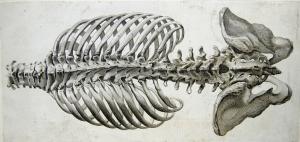Membrane-Initiated Estrogen Receptor α (mERα) in Specific Cell Types Found Crucial for Bone Strength
Disabling mERα in female mice reduced cortical bone mass, the dense outer layer of bones that provides strength and protection
CHENGDU, SICHUAN, CHINA, July 9, 2025 /EINPresswire.com/ -- Estrogen plays an important role in keeping bones healthy. Now, researchers investigated how membrane-initiated estrogen receptor alpha (mERα) signaling in specific cell types of female mice affects bone health. They found that mERα activity in bone-forming cells (osteoblasts) is crucial for maintaining strong cortical bone, while its role in hematopoietic cells is minimal. These findings provide insights into how estrogen protects bone and could help develop safer therapies that strengthen bones without unwanted side effects.Estrogen plays a crucial role in maintaining bone health by supporting bone growth, development, and remodeling, which is the balance between bone formation and resorption. In women, low estrogen levels after menopause can lead to osteoporosis, a condition where bones become weaker and are more prone to fractures. While hormone replacement therapy can help prevent bone loss by restoring estrogen levels, its widespread use is limited because estrogen affects many different systems in the body, making side effects possible, such as an increased risk of certain cancers and blood clots.
To develop safer treatments, it is vital to understand how estrogen protects bones. The protective effects of estrogen mainly occur through estrogen receptor alpha (ERα), a protein found in many cells throughout the body. When estrogen binds to ERα, it activates signals inside cells that help to maintain bone mass and strength. Without this signaling, bones can lose density and become more fragile.
In a recent study published online in the journal Bone Research on June 17, 2025, Dr. Karin Horkeby from the University of Gothenburg in Sweden, collaborated with researchers from the University of Oulu in Finland, and the Sahlgrenska University Hospital in Sweden and examined the effect of membrane-initiated ERα (mERα) signaling in osteoblast lineage cells, which are responsible for building new bone. This pathway differs from the ERα pathway because it operates at the cell membrane rather than within the cell's nucleus. “Earlier research using mouse models suggested that this membrane pathway might be important for maintaining bone mass in a tissue-specific manner, but it was unclear which bone cells depend on this mERα signaling pathway,” says Dr. Horkeby. Against this backdrop, the researchers investigated the effects of mERα signaling on specific cell types.
The researchers created a unique female mouse model (Runx2-C451Af/f mice) in which mERα signaling was selectively turned off in osteoblast lineage cells. By scanning the bones using high-resolution microcomputed tomography, they found that mice lacking mERα signaling in these cells consistently had lower cortical bone mass (the dense, hard outer layer of bones) in their tibia, femur, and vertebrae compared to normal mice. Additional bending tests indicated that these bones were weaker and fractured more easily. Furthermore, when the researchers grew osteoblasts from mice in which mERα signaling were turned off in the laboratory, they found that the cells did not differentiate properly compared to normal cells. These results suggest that the mERα signaling pathway is essential for osteoblasts to mature fully and for maintaining the strength and density of cortical bone.
The researchers also investigated the effect of mERα signaling in hematopoietic (blood-forming) cells, which include immune cells and osteoclasts, the cells responsible for breaking down bone. To deactivate mERα signaling in these cells, they transplanted bone marrow from mice with the mERα-blocking mutation into healthy wild-type mice. Unlike in osteoblasts, disabling mERα signaling in blood-forming cells had no impact on bone mass or structure, indicating that this membrane pathway in hematopoietic cells is not crucial for maintaining bone mass.
While the loss of membrane signaling significantly affected cortical bone, its impact on trabecular bone (the spongy inner part) was minimal, except for a reduction in the tibia. This suggests that the membrane pathway may play a more specialized role in supporting the bone's hard outer shell compared to its spongy interior.
Importantly, disabling mERα signaling in osteoblasts did not disrupt estrogen's other functions in the body. The mice remained healthy, with normal body weight, sex hormone levels, and reproductive organ weights, suggesting that altering mERα signaling in osteoblasts is unlikely to cause side effects.
These findings contribute to the growing understanding of how estrogen supports bone health. They demonstrate that membrane-initiated ERα signaling in osteoblast lineage cells is crucial for maintaining cortical bone mass and strength in female mice.
“The results demonstrated that mERα signaling in osteoblast lineage cells plays a crucial role in regulating female cortical bone, while mERα signaling in hematopoietic cells of adult female mice is dispensable for bone regulation,” notes Dr. Horkeby.
These insights could pave the way for new, safer treatments that target specific bone cell pathways, allowing us to harness the benefits of estrogen for bone health while minimizing its risks elsewhere in the body.
***
Reference
Title of original paper: Membrane-initiated estrogen receptor-α signaling in osteoblasts is crucial for normal regulation of the cortical bone in female mice
Journal: Bone Research
DOI: 10.1038/s41413-025-00439-8
Yini Bao
West China School of Stomatology, Sichuan University
br@scu.edu.cn
2885546461 ext.
Visit us on social media:
X
Legal Disclaimer:
EIN Presswire provides this news content "as is" without warranty of any kind. We do not accept any responsibility or liability for the accuracy, content, images, videos, licenses, completeness, legality, or reliability of the information contained in this article. If you have any complaints or copyright issues related to this article, kindly contact the author above.

